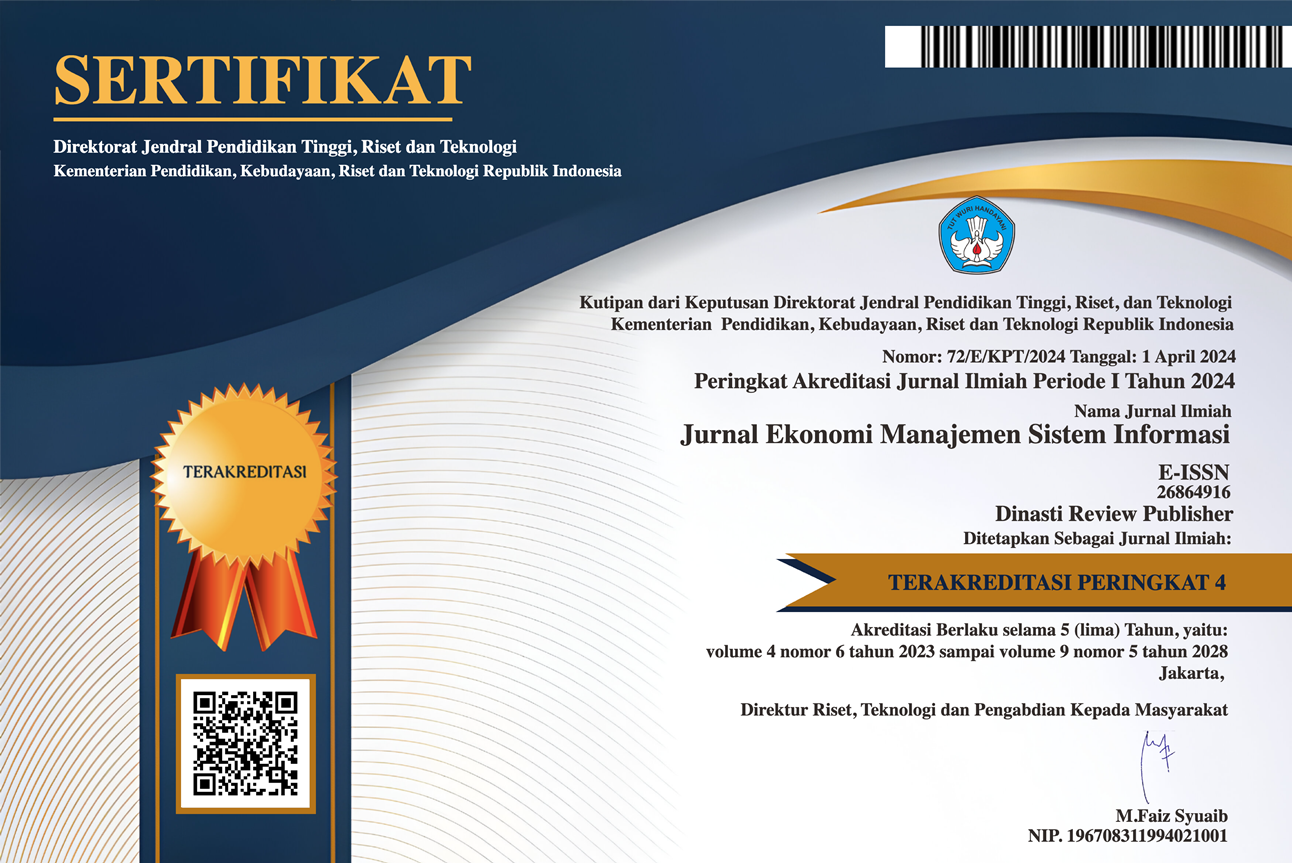The Influence of User Generated Content (UCG) on Skincare Product Purchase Decisions Among Generation Z on TikTok ( A Case Study in Bandung City)
DOI:
https://doi.org/10.38035/jemsi.v6i5.5049Keywords:
User Generated Content, Purchase Decision, Skincare Product, TikTokAbstract
This study seeks to explore the influence of User Generated Content (UGC) on the purchase decisions of skincare products among Generation Z users on TikTok, using Bandung City as a case study. The research targets individuals from Generation Z who are active TikTok users and reside in Bandung. A purposive sampling technique was used, resulting in a total sample of 155 respondents. Data were collected through a questionnaire distributed via Google Forms to Generation Z users who meet the criteria. The analysis technique used is descriptive analysis and simple linear regression analysis using SPSS software. The findings reveal that User Generated Content (UGC) has a positive and significant effect on the skincare purchase decisions of Generation Z on TikTok, accounting for 40.5% of the variation in purchasing decisions.
References
Agustina, L. (2020). Viralitas Konten Di Media Sosial. Majalah Ilmiah Semi Populer Komunikasi Massa, 1(2), 149–160. https://www.researchgate.net/publication/348296842
Anwar, I., & Reham, K. U. (2013). FACTORS AFFECTING CONSUMER ATTITUDES USER-GENERATED PRODUCT CONTENT ON YOUTUBE Imran Anwar MIR Kashif Ur REHMAN. Management & Marketing, 8(4), 637–654. http://search.proquest.com.ezproxy.library.uq.edu.au/docview/1503088220?pq-origsite=summon
Arnhold, U. (2010). User Generated Branding: Intergrating User Generated Content into Brand Management. Gabler Verlag. https://doi.org/007/978-3-8349-8857-7
Asosiasi Penyelenggara Jasa Internet Indonesia. (2024). 221 Juta Penduduk Indonesia Makin Melek sama Internet. Indonesiabaik.Id.
Assauri, S. (2014). Manajemen Pemasaran: Dasar, Konsep & Strategi. PT Rajagrafindo Persada.
Chaniago, H., Muharam, H., & Efawati, Y. (2023). Metode Riset Bisnis Dan Permodelan (E. Yen (ed.); Vol. 1). PT Edukasi Riset Digital. https://digilib.polban.ac.id/files/disk1/311/jbptppolban-gdl-harmonchan-15510-1-metoder-n.pdf
Dila Khoirin anisa, & Novi Marlena. (2022). Pengaruh User Generated Content Dan E-Wom Pada Aplikasi Tik-Tok Terhadap Purchase Intention Produk Fashion. Jurnal Sinar Manajemen, 9(2), 207–218. https://doi.org/10.56338/jsm.v9i2.2610
Faizatul Wafiyah, & Any Urwatul Wusko. (2023). Pengaruh User Generated Content Dan E-Wom Terhadap Purchase Intention Dan Purchase Decision Pada Pembeli Produk Nyrtea Di Instagram. Jurnal Ekonomi, Bisnis Dan Manajemen, 2(3), 190–200. https://doi.org/10.58192/ebismen.v2i3.1278
Gautama, V. A. (2022). User Generated Content pada Tiktok dan Penggunaannya di Kalangan Muda. Jurnal Ilmu Sosial Dan Pendidikan (JISIP), 6(4), 2598–9944. https://doi.org/10.36312/jisip.v6i4.3749/http
Ghozali, I. (2016). Aplikasi Analisis Multivariete Dengan Program IBM SPSS 23. (Edisi 8). Badan Penerbit Universitas Diponegoro.
GoodStats. (2024). 10 Negara dengan Pengguna TikTok Terbesar, Indonesia Urutan Berapa? GoodStats.
Hair Jr, J. F., Black, W. C., Babin, B. J., & Anderson, R. E. (2010). Multirative Data Analysis (Vol. 12, Issue 12). Pearson Educatuib Limited. https://doi.org/10.3390/polym12123016
Handayani, S. (2012). MODEL HOWARD & SHETH SEBAGAI ALTERNATIF MEMAHAMI PERILAKU KONSUMEN DALAM MANAJEMEN PEMASARAN (SB. Handayani, SE MM) ABSTRAK. Dharma Ekonomi, April(35), 1–13.
Hayat, M. A., Hermawan, A., & Nuryadin, A. (2024). Pengaruh Social Media Marketing dan User Generated Content terhadap Purchase Decision Produk Luxcrime pada Generasi Z di TikTok. Urnal Ekonomi Digital, 12(1), 45–47.
Khofifah, R. N., & Hasanah, K. (2023). Analisis Keputusan Pembelian Pada Instagram Melalui Variabel Perceived Value Sebagai Intervening. Management and Accounting Expose, 6(1), 97–109. https://doi.org/10.36441/mae.v6i1.1080
Kotler, P., & Keller, K. L. (2016). A Framework for Marketing Management. In Sustainability (Switzerland) (Vol. 11, Issue 1). Pearson Educatuib Limited. http://scioteca.caf.com/bitstream/handle/123456789/1091/RED2017-Eng-8ene.pdf?sequence=12&isAllowed=y%0Ahttp://dx.doi.org/10.1016/j.regsciurbeco.2008.06.005%0Ahttps://www.researchgate.net/publication/305320484_SISTEM_PEMBETUNGAN_TERPUSAT_STRATEGI_MELESTARI
Mathur, S., Tewari, A., & Singh, A. (2021). Modeling the Factors affecting Online Purchase Intention: The Mediating Effect of Consumer’s Attitude towards User- Generated Content. Journal of Marketing Communications, 00(00), 1–20. https://doi.org/10.1080/13527266.2021.1936126
Meltwater. (2024). Social Media Statistics for Indonesia [Updated 2024]. Meltwater.
Nisrina, R. G. (2021). User generated content sebagai strategi komunikasi pemasaran digital: studi kasus fenomena #shopeehaul. Jurnal Komunikasi Profesional, 5(6), 558–571. https://doi.org/10.25139/jkp.v5i6.4316
O’Hern, M. S., & Kahle, L. R. (2013). The Empowered Customer: User-Generated Content and the Future of Marketing. Global Economics and Management Review, 18(1), 22–30. https://doi.org/10.1016/s2340-1540(13)70004-5
Pallant, J. (2016). A step-by-step guide to data analysis using SPSS version 15. Mc Graw Hill.
Putri, W., Levyda, L., & Hardiyanto, T. (2021). Cahyo dan Wahyudi Lilik, Analisis Pengaruh Kepercayaan Atas Merek pada Ekuitas Merek. Jurnal Bisnis dan Manajemen:2019), Vol. 9 No. 1. Management & Accounting Expose, 4(2), 129–138.
Rizaty, M. A. (2025). Data Pengguna Aplikasi TikTok di Indonesia 4 Tahun Terakhir hingga Oktober 2024. Dataindonesia.Id. https://dataindonesia.id/internet/detail/data-pengguna-aplikasi-tiktok-di-indonesia-4-tahun-terakhir-hingga-oktober-2024
Rubyanti, D., & Irwansyah, I. (2020). Peran User Generated Content (Ugc) Instagram Pada Industri Makanan. Mediakom, 4(1), 1–24. https://doi.org/10.32528/mdk.v4i1.3569
TikTok Creative Center. (2025). Explore Top Products on TikTok. https://ads.tiktok.com/business/creativecenter/top-products/pc/en?rid=dlv4wtcjy7p
Timoshenko, A., & Hauser, J. R. (2019). Identifying customer needs from user-generated content. Marketing Science, 38(1), 1–20. https://doi.org/10.1287/mksc.2018.1123
Wiguna, K. D. (2022). PENGARUH SUBJECTIVE NORM, PERCEIVED USEFULNESS, DAN VIDEO REVIEW PRODUK TERHADAP KEPUTUSAN PEMBELIAN PERALATAN RUMAH TANGGA DI MARKETPLACE DENGAN MINAT BELI SEBAGAI VARIABEL INTERVENING. Jubis, 3(1).
Z.Nur, L., Hernita, N., & Puspita, D. (2024). Pengaruh User Generated Content Dan Brand Image Terhadap Keputusan Pembelian (Studi Pada Mahasiswa Unma Pengguna Produk Skincare the Originote). EKBIS (Ekonomi & Bisnis), 12(1), 12–24. https://doi.org/10.56689/ekbis.v12i1.1312
Downloads
Published
How to Cite
Issue
Section
License
Copyright (c) 2025 Aflah Malik Alghaniy

This work is licensed under a Creative Commons Attribution 4.0 International License.
Hak cipta :
Penulis yang mempublikasikan manuskripnya di jurnal ini menyetujui ketentuan berikut:
- Hak cipta pada setiap artikel adalah milik penulis.
- Penulis mengakui bahwa Jurnal Ekonomi Manajemen Sistem Informasi (JEMSI) berhak menjadi yang pertama menerbitkan dengan lisensi Creative Commons Attribution 4.0 International (Attribution 4.0 International CC BY 4.0) .
- Penulis dapat mengirimkan artikel secara terpisah, mengatur distribusi non-eksklusif manuskrip yang telah diterbitkan dalam jurnal ini ke versi lain (misalnya, dikirim ke repositori institusi penulis, publikasi ke dalam buku, dll.), dengan mengakui bahwa manuskrip telah diterbitkan pertama kali di Jurnal Ekonomi Manajemen Sistem Informasi (JEMSI).










































































